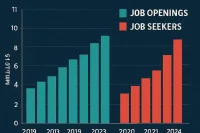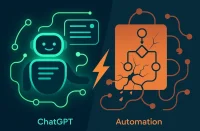AI coding tools are more popular than ever but often failing silently, producing code that’s almost right but never quite there, which is extremely frustrating for developers. According to Stack Overflow, 66% of developers say the worst part of coding with AI is receiving responses that aren’t quite correct – they get you almost there but never quite reach the finish line. This leads many developers to abandon AI tools or constantly search for new ones, creating a cycle where the time spent finding solutions often negates the benefits of using AI assistance in the first place.
The core problem lies in the lack of transparency and control that traditional AI coding tools provide. Developers create a prompt and then become essentially blind to what happens underneath, lacking the ability to guide, refine, or interrupt the AI’s process. This creates a gap between the initial prompt and the final production code, leaving developers without the control they need to ensure code compiles correctly, follows proper style guidelines, and maintains security standards.
The solution to this pervasive problem is a concept called agent steering, which allows developers to guide AI in real-time rather than just receiving code passively. This revolutionary approach keeps developers in control while leveraging AI’s capabilities, creating a collaborative relationship rather than a one-way interaction.
The Silent Failure Problem: When Almost Right Isn’t Good Enough
These tools produce code that appears correct at first glance but contains subtle errors, logic flaws, or doesn’t quite match the developer’s intent. This creates a dangerous situation where developers might deploy code that seems functional but contains hidden bugs or security vulnerabilities.
The frustration stems from the fact that AI tools often get 90% of the way to the correct solution but miss crucial details that make the difference between working code and production-ready software. This “almost right” problem is particularly insidious because it requires developers to spend significant time debugging and correcting AI-generated code, often negating the time-saving benefits that AI tools are supposed to provide.
The lack of transparency in traditional AI tools means developers can’t see how the AI arrived at its solution, making it difficult to understand why certain decisions were made or how to guide the AI toward better results. This creates a black box effect where developers must accept whatever the AI produces without the ability to influence the process.
Agent Steering: The Solution to Silent Failures
This pervasive problem can be solved through agent steering, a revolutionary approach that gives developers real-time control over AI-generated code. This concept allows developers to review, edit, and refine AI responses as they’re being generated, creating a collaborative development process rather than a passive code generation system.
Agent steering works by surfacing AI-generated changes as inline diffs that developers can review, edit, or reject directly without context switching. This approach maintains developer control while leveraging AI capabilities, ensuring that the final code aligns with project conventions, style guidelines, and security requirements.
The key advantage of agent steering is the ability to interrupt and retry AI processes, attach additional context like files or code selections, and refine prompts in real-time. This eliminates the frustration of waiting for AI responses that might not be quite right, allowing developers to guide the AI toward better solutions immediately.
Real-Time Collaboration: Working With AI, Not Against It
These tools lack the collaborative features that make AI truly useful for developers, creating frustration and inefficiency. Agent steering transforms the relationship between developers and AI from a one-way interaction to a true collaboration where both parties work together toward a common goal.
The ability to interrupt AI processes and provide additional context creates a dynamic development environment where developers can guide AI responses based on their specific needs and project requirements. This real-time collaboration ensures that AI-generated code meets the developer’s standards and integrates seamlessly with existing codebases.
The collaborative nature of agent steering also makes it an excellent learning tool for developers who want to improve their coding skills. Rather than replacing the learning process, agent steering enhances it by providing immediate feedback and allowing developers to understand how AI approaches different coding challenges.
Transparency and Control: Seeing What AI Is Doing
Traditional tools lack transparency in their decision-making process, creating a black box effect that frustrates developers. Agent steering addresses this by providing developers with visibility into how AI is approaching problems and what steps it’s taking to generate solutions.
This transparency allows developers to understand the AI’s reasoning process and make informed decisions about whether to accept, modify, or reject AI-generated code. The ability to see the AI’s thought process also helps developers learn new coding techniques and approaches they might not have considered otherwise.
The control aspect of agent steering ensures that developers remain fully responsible for the code they submit, maintaining professional standards and ensuring that all code meets project requirements. This responsibility is crucial in professional development environments where code quality and security are paramount.
Performance and Speed: Getting Results Quickly
Many AI coding tools suffer from slow response times that make them impractical for real-time development work. Agent steering addresses this by providing fast, responsive AI interactions that keep developers in their flow state.
The speed of agent steering responses is crucial for maintaining developer productivity, as delays in AI responses can disrupt coding flow and reduce efficiency. The ability to get quick feedback and make immediate adjustments keeps developers engaged and productive throughout the development process.
The real-time nature of agent steering also allows for iterative development where developers can quickly test different approaches and refine their solutions based on immediate feedback from the AI system.
Context Awareness: Understanding Your Codebase
These tools lack context about the specific project, coding standards, and architectural decisions that developers are working with. Agent steering addresses this by providing contextual intelligence that ensures AI outputs align with project conventions.
The ability to attach context like files, diffs, or code selections allows AI to understand the broader project structure and make more informed decisions about code generation. This context awareness is crucial for maintaining consistency across large codebases and ensuring that AI-generated code integrates properly with existing systems.
Contextual intelligence also helps AI understand project-specific requirements, coding standards, and architectural patterns, ensuring that generated code follows established conventions and best practices.
The Learning Factor: Enhancing Developer Skills
Traditional AI coding tools can actually hinder developer learning by providing solutions without explanation or context. Agent steering enhances the learning process by allowing developers to understand how AI approaches different problems and learn new techniques in the process.
The collaborative nature of agent steering means that developers remain actively engaged in the coding process rather than passively accepting AI-generated solutions. This active engagement helps developers improve their skills while leveraging AI capabilities to explore new approaches and techniques.
The ability to refine and modify AI-generated code also helps developers understand different coding patterns and approaches, expanding their knowledge base and improving their overall coding abilities.
Enterprise and Team Development: Scaling AI Assistance
These tools often fail in team environments where consistency and code quality are crucial for successful collaboration. Agent steering provides the control and transparency needed for enterprise development while maintaining the benefits of AI assistance.
The ability to customize agent behavior and maintain project-specific conventions ensures that AI assistance scales effectively across large development teams. The collaborative nature of agent steering also facilitates knowledge sharing and code review processes that are essential for team development.
The contextual intelligence provided by agent steering helps maintain consistency across different parts of large codebases, ensuring that AI-generated code follows established patterns and conventions throughout the project.
The Future of Development: Agentic Development Environments
This represents a transitional phase in the evolution of development tools toward more integrated and collaborative solutions. The future lies in agentic development environments that combine AI, editing, review, and context tracking in a single integrated platform.
This vision eliminates the need for separate IDEs by providing a terminal-based environment that combines all the tools developers need in one place. The integration of AI assistance with development tools creates a seamless workflow that enhances productivity while maintaining developer control and responsibility.
The agentic development environment represents a fundamental shift in how developers interact with AI tools, moving from passive code generation to active collaboration that enhances rather than replaces human expertise.
Frequently Asked Questions
What does AI coding tools are more popular than ever but often failing silently mean?
AI coding tools are more popular than ever but often failing silently means that while AI coding assistance is widely adopted, these tools frequently produce code that appears correct but contains subtle errors or doesn’t quite match developer intent, creating frustration and inefficiency.
How does AI coding tools are more popular than ever but often failing silently affect developer productivity?
AI coding tools are more popular than ever but often failing silently can actually reduce productivity by requiring developers to spend time debugging and correcting AI-generated code, negating the time-saving benefits these tools are supposed to provide.
What is the solution to AI coding tools are more popular than ever but often failing silently?
The solution is agent steering, which gives developers real-time control over AI responses, allowing them to review, edit, refine, and guide AI-generated code to ensure it meets their standards and project requirements.
How can developers avoid the problems with AI coding tools are more popular than ever but often failing silently?
Developers can avoid these problems by using tools that provide transparency, real-time control, and collaborative features that allow them to guide AI responses and maintain responsibility for the code they submit.
A Real-World Example: Sarah’s Development Journey
Sarah Chen, a 28-year-old software engineer from San Francisco, exemplifies how AI coding tools are more popular than ever but often failing silently can frustrate developers. After struggling with traditional AI coding tools that produced “almost right” code, Sarah discovered agent steering and transformed her development workflow.
“I was constantly frustrated because AI coding tools are more popular than ever but often failing silently,” Sarah explains. “I’d get code that looked correct but had subtle bugs or didn’t follow our team’s coding standards. I spent more time fixing AI-generated code than I saved by using the tools.”
Sarah’s experience with agent steering changed her perspective completely. The ability to guide AI responses in real-time and maintain control over the development process allowed her to leverage AI capabilities while ensuring code quality and consistency.
“AI coding tools are more popular than ever but often failing silently taught me that the key is maintaining control and transparency,” Sarah says. “With agent steering, I can guide the AI toward better solutions and understand how it approaches different problems, which actually helps me learn and improve my own coding skills.”
Within six months of using agent steering, Sarah increased her development productivity by 40% while maintaining higher code quality standards. Her experience demonstrates that the future of AI-assisted development lies in collaborative tools that enhance rather than replace human expertise.




